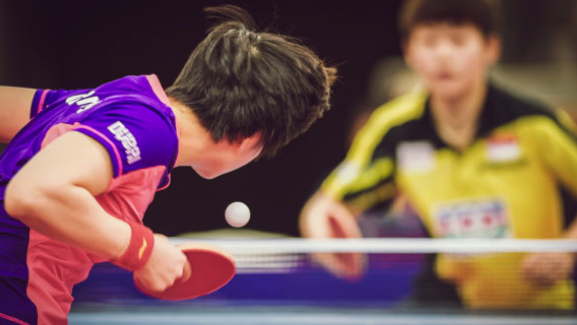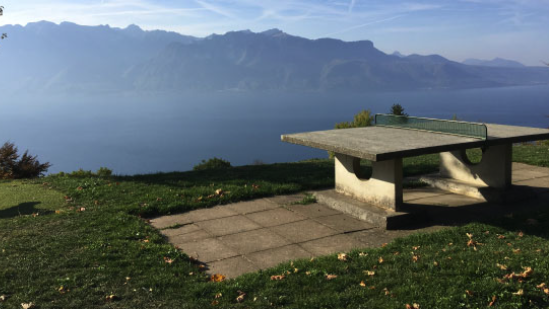Getting your Trinity Audio player ready...
When watching competitive table tennis, one might wonder how this sport seemingly appears to defy the laws of physics. Balls can travel at speeds exceeding 100 km/h, rotate backward and abruptly change direction, and players seem to make seemingly impossible hits successfully. A complex combination of the balls’ composition, different racket coverings and players’ skills results in a spectacular game, with an exciting scientific foundation.
Other stories:
Basic Physics
Newtonian (or ‘classical’) mechanics provides a basic framework for understanding table tennis, as it can describe the forces, speeds, and directions resulting from the collision of two objects, such as a racket striking a ball or a ball bouncing off the table.
4 View gallery


Table tennis balls. In an effort to slow down gameplay and enhance viewer experience, the International Table Tennis Federation increased the official ball diameter from 38mm to 40mm in the year 2000
(Photo: sportoakimirka,, Shutterstock)
Newton’s first law of motion states that a resting object will remain at rest until a force is applied to it, just like a table tennis ball remains stationary before the first serve.
According to Newton’s second law of motion, the force acting on an object is equal to its acceleration (the rate of change in velocity) multiplied by its mass. With the table tennis ball having a constant mass of 2.7 grams, hitting a ball with a 40 N (newtons) of force will result in an initial acceleration of approximately 15,000 m/s^2.
Newton’s third law of motion states that for every action there is an equal reaction in the opposite direction. When a moving ball hits the table, it exerts a force on the table, and the table exerts a force on the ball. Similarly, when a player hits a ball with the racket, opposite forces apply to the ball and to the racket in the player’s hand.
The history of the ping pong ball
Historically, table tennis balls were produced from cork. In the year 1900, 38 mm diameter celluloid balls were introduced. Toward the end of the 20th century, due to advancements in the technology of racket coverings, and increasingly skillful players, the game became faster-paced, making it hard to follow (and enjoy) as a spectator. In the year 2000, the International Table Tennis Federation (ITTF) addressed this issue by increasing the ball diameter to 40 mm in order to effectively slow down the game.
The effect of slowing the game results from two physical characteristics. First, the 40 mm ball is heavier than its predecessor, leading to an increased effect of gravity slowing down the ball in flight. Second, the larger diameter leads to an increased air resistance on the ball, further reducing its speed.
4 View gallery


The transition from celluloid to non-flammable plastic balls in 2014 affected the game’s dynamics. The harder surface of plastic balls reduced spin susceptibility, providing an advantage to players with aggressive attack-oriented styles
(Photo: Nomad_Soul, Shutterstock)
While celluloid has great physical properties that enable fast spins and hits, it’s also highly flammable, making its production process hazardous. To mitigate the health risk for ball manufacturing workers, the material of the ball was changed to a non-flammable plastic in 2014. While the plastic balls match the size and weight of the celluloid balls, they have a harder surface, making them less susceptible to spins, since a ball with a harder surface spends a shorter time interacting with the surface of the racket, giving it less time to introduce a spin. This change has favored players with a more aggressive attack-oriented playing style without much emphasis on spin.
Depending on the situation and the player’s style, a table tennis ball might have considerable rotation – known as spin – in any given direction. Players use spin for two main reasons: First, spinning balls follow different trajectories compared to clear hits (without spin), making it possible for players to reach the table from angles and positions that would be unattainable without rotation. Second, spin hits are more difficult to respond to. Responding with a simple hit to a ball with side spin will send the ball toward the side of the table, a ball with a backspin is more likely to land at the base of the net and a ball with topspin is more likely to result in an overly long trajectory. Therefore, spinning balls require the opponent to recognize and compensate for the rotation. The curving of spinning balls through the air is explained by the Magnus effect.
4 View gallery


A table tennis tournament. The player's skill at applying spin to the ball can drastically alter its trajectory and present a challenge for the opponent, who must correctly anticipate and compensate for the ball's rotation. This curving motion is explained by the Magnus effect
(Photo: Stefan Holm, Shutterstock)
Spins are applied to the ball using the friction between the ball and the polymeric racket cover. Different types of racket covers allow for a variety of player styles and preferences. Softer covers result in a longer interaction between the ball and the racket, generating more friction and more spin. On the other hand, the soft surface leads to a considerable loss of the ball’s speed. The payoff between spin and speed means that players with what would be considered ‘’attacking’’ styles typically prefer to choose thinner polymer coatings, which offer less spin but higher speed.
Geographical Location of The Competition
Air resistance and gravity are the two major forces slowing down the ball after it is hit by the racket. Gravity “pulls” the ball downwards, and is independent of the ball’s speed. Air resistance, on the other hand, exerts pressure opposing the direction of flight. Air resistance varies with the square of the ball’s speed, meaning that the faster the ball travels, the more it is slowed down by air resistance.
While the gravitational field doesn’t change considerably between different locations on Earth, air pressure is strongly dependent on altitude. Playing table tennis at the summit of Mount Everest (8,848 m) would feel very different compared to playing at the Dead Sea (-420 m), as the air pressure at the highest point on Earth is only about 33% of that at its lowest. This means that a ball will reach your opponent much faster on Mount Everest than the same hit at the Dead Sea. In such situations, even experienced players would, most likely, exert too much force when hitting the ball.
4 View gallery


A ping pong table high in the mountains. Altitude directly affects gameplay dynamics, since the reduced air pressure causes the ball to move faster than it would at lower altitudes
(Photo: Ruslan Schneider, Shutterstock)
While comparing the highest and lowest place on Earth is extreme, players can notice the difference between sea-level table tennis venues (e.g. Tel Aviv) and mountain locations (e.g. El Alto in Bolivia, at 3,800 m).
Table tennis players develop an intuition for the game’s physics, but playing in peculiar venues requires longer training periods at the specific location to adapt to the unique conditions.

